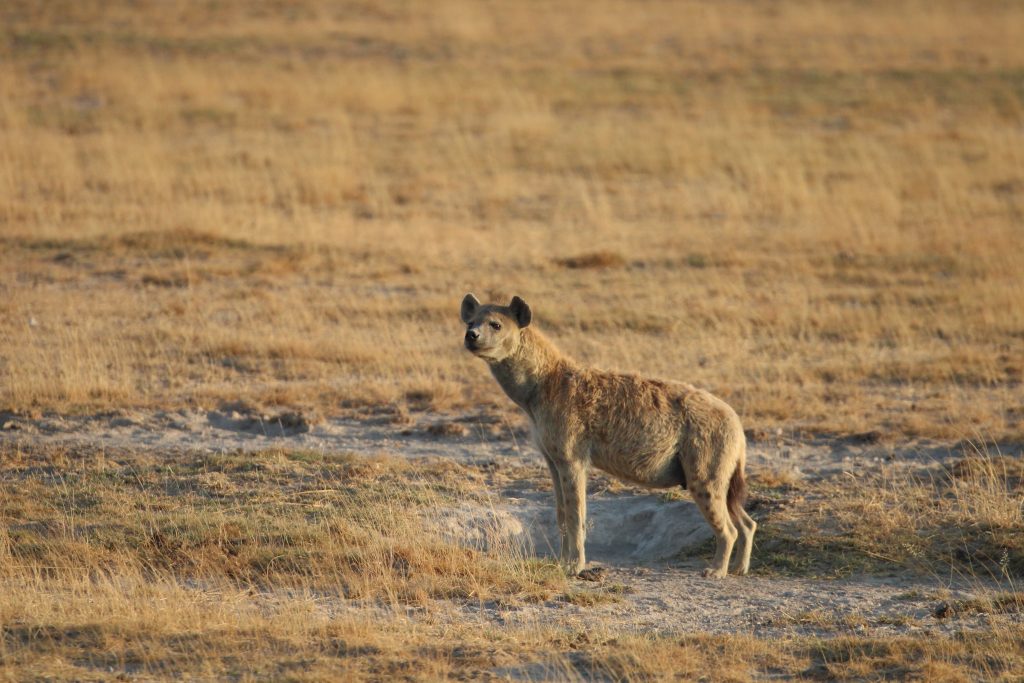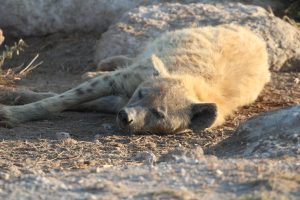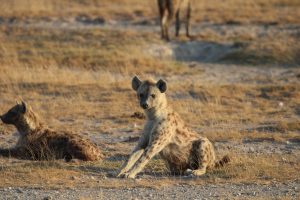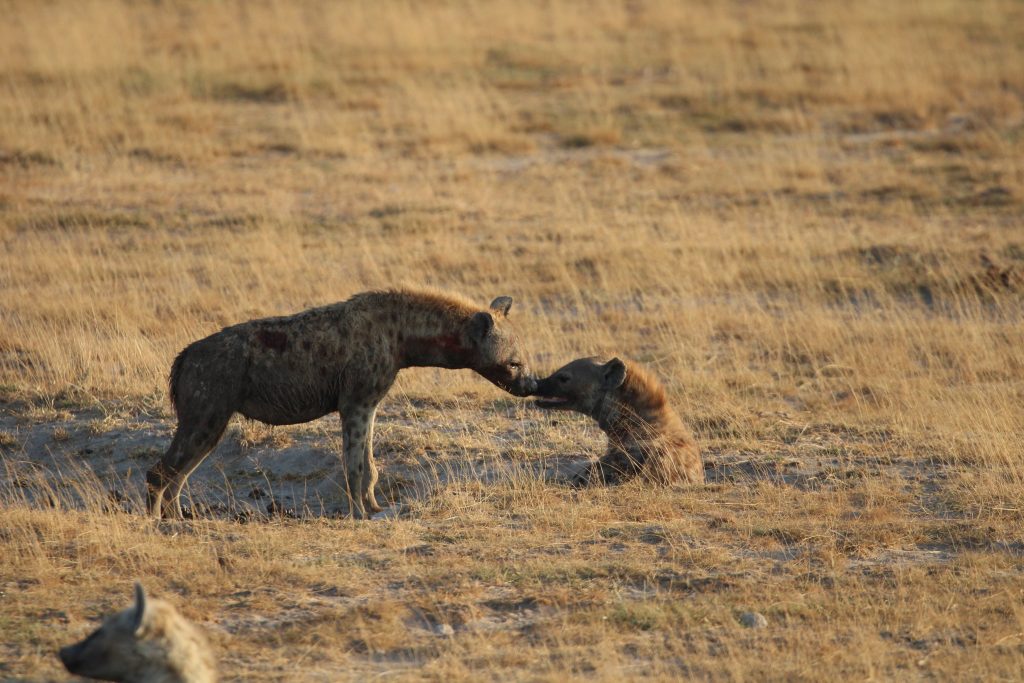Hyenas – a misunderstood species
Have we misjudged the hyena? Our Conservation Officer, Joe Hedges, considers the relationship people have with hyenas.

Hyenas are probably one of the most misunderstood species on the planet – their role in the natural environment is disregarded and they are often viewed as a ‘pest’.
Yet they are fascinating animals and, like every other species, perform vital roles in their ecosystem. Without them, the landscape would be transformed, for the worse.
Although many may not realise it, people rely on hyenas as well.
How people view hyenas
Hyenas undoubtably have a complex relationship with people. In an ecosystem which includes lions, leopards, cheetahs, elephants, giraffe and many other emblematic species, hyenas can get forgotten.
They are not the most striking, the most elegant or the most impressive looking animal – their short hindquarters and sloping backs give them a somewhat awkward gait and their chattering, laughing calls can sound unnerving.
Sadly, in many parts of the world they are a relatively unloved animal, an attitude exacerbated by their portrayal in pop culture (think of the way the three hyenas are depicted in Disney’s Lion King). Across parts of their range, hyenas have been associated with witchcraft, often leading to them being feared or disliked by local people.
If you type ‘Why are hyenas…’ into a search engine, the recommended searches include ‘so ugly’, ‘so dangerous’, ‘so hated’ and ‘so cruel’, clearly demonstrating the negative attitudes society can have towards hyenas. By comparison, when searching ‘Why are lions…’, the recommended searches include ‘the king of the jungle’ and ‘so important’.
Hyena family groups
 Our attitude towards hyena is hugely unjust. Hyenas have equally interesting behaviours and ecology as lions, leopards, or cheetahs. There are four recognised species in the unique Hyaenidae family – spotted hyenas, striped hyenas, brown hyenas, and aardwolves.
Our attitude towards hyena is hugely unjust. Hyenas have equally interesting behaviours and ecology as lions, leopards, or cheetahs. There are four recognised species in the unique Hyaenidae family – spotted hyenas, striped hyenas, brown hyenas, and aardwolves.
Whereas spotted and brown hyena are sociable, living in family units called ‘clans’, striped hyenas and aardwolves tend to live solitarily or in pairs. Clans are highly territorial, centred around an underground den where cubs are raised, and members of the clan meet to re-establish their bonds.
Clans are matrilineal societies, led by an alpha-female, much like elephants but interestingly quite unlike other carnivores. Hyena cubs are unusually dependent on their mothers for milk – likely because kills are normally made far away from the den – suckling for between 12 to 18 months, longer than most other carnivores.
Cubs are looked after by babysitters, usually a close relative, whilst their mother is out hunting, and they join their mothers on scavenging and hunting trips once they are a year old.
Living alongside hyenas
However, for people that live alongside them, hyenas can pose a real threat to their livelihoods.
Despite being well known as scavengers, hyenas in fact hunt the majority of their prey and, when wild prey becomes scarce, hyenas, like many other carnivores, may turn to livestock. Livestock predation is a significant issue in landscapes such as Amboseli and Meru, Kenya, where Born Free has been operating our own conservation projects since 2010 and 2014 respectively.
In these two landscapes, hyenas often cause more than half of all predation events by carnivores. Speaking with local people clearly tells this story – when you ask which animal they consider the most problematic you invariably hear fisi – Swahili for hyena. As with lions, hyenas subsequently can become victims to retaliatory killings, often by poisoning.
Contrary to conflict between people and lions, there has been much less attention paid to human-hyena conflict, so the impact of retaliatory killing on their populations is less well understood.
Despite being classified as Least Concern by the IUCN*, populations of spotted hyena, the most common hyena species, are declining, with fewer than 50,000 estimated to remain across the African continent.
The impact of hyenas on the landscape
Losing hyenas in the landscape would have catastrophic consequences. As predators, hyenas help to prevent over-population of herbivore species such as waterbuck. This prevents overgrazing of grasslands, benefitting all species in the landscape.
Hyenas have one of the strongest jaws in relation to their size of any carnivore, meaning that they can crush and eat bones left unutilised by other predators.
Their scavenging behaviour also plays a crucial role for people and livestock – hyenas are often described as the ‘cleaners of the landscape’ because they remove carcasses, and this helps to prevent the spread of diseases such as anthrax. Without hyenas, grasslands could become overpopulated and disease prevalent.
It is certainly time hyenas were shown more appreciation!
Coexisting with hyenas
 Before we can hope for a change in attitude of local people towards hyenas, we must empower these people to humanely protect their livestock, enabling coexistence with this ‘difficult’ animal.
Before we can hope for a change in attitude of local people towards hyenas, we must empower these people to humanely protect their livestock, enabling coexistence with this ‘difficult’ animal.
Many of Born Free’s conflict mitigation strategies do not solely prevent conflict with lions – they are also effective at preventing hyena predation on livestock.
Hyenas are incredibly intelligent animals, and often find a weakness in traditional ‘bomas’ (livestock enclosures), but Born Free’s reinforced, predator-proof bomas in Amboseli have helped prevent even the most determined hyenas from getting in.
To make a predator-proof bomas ‘hyena-proof’, we bury chain-link fencing deep into the ground, preventing hyenas from digging their way in – their usual tactic to get into bomas. Furthermore, our recent trials of predator-deterrent lights in Meru have also been well received by local pastoralists.
They report that, where they had regularly experienced hyena predation previously, since the lights were installed, they have not lost any livestock. One livestock owner told us that when hyenas recently visited at night, they circled his homestead before leaving with no kill.
This is an important first step in achieving coexistence and good news that many of Born Free’s current human-lion conflict mitigation strategies also seem to be effective at preventing hyena predation. Nevertheless, we will continue to search for simple and innovative solutions to address conflict with hyenas in these landscapes.
Hyenas are not cruel, unclean, or ugly – they are highly intelligent, with complex social structures and play an important role in the environment. They deserve the respect and appreciation given to their fellow predators and should be able to live without the threat of persecution.
In an increasingly human-dominated world, we must strive to achieve harmonious coexistence with all species, including those traditionally considered ‘pests’.

